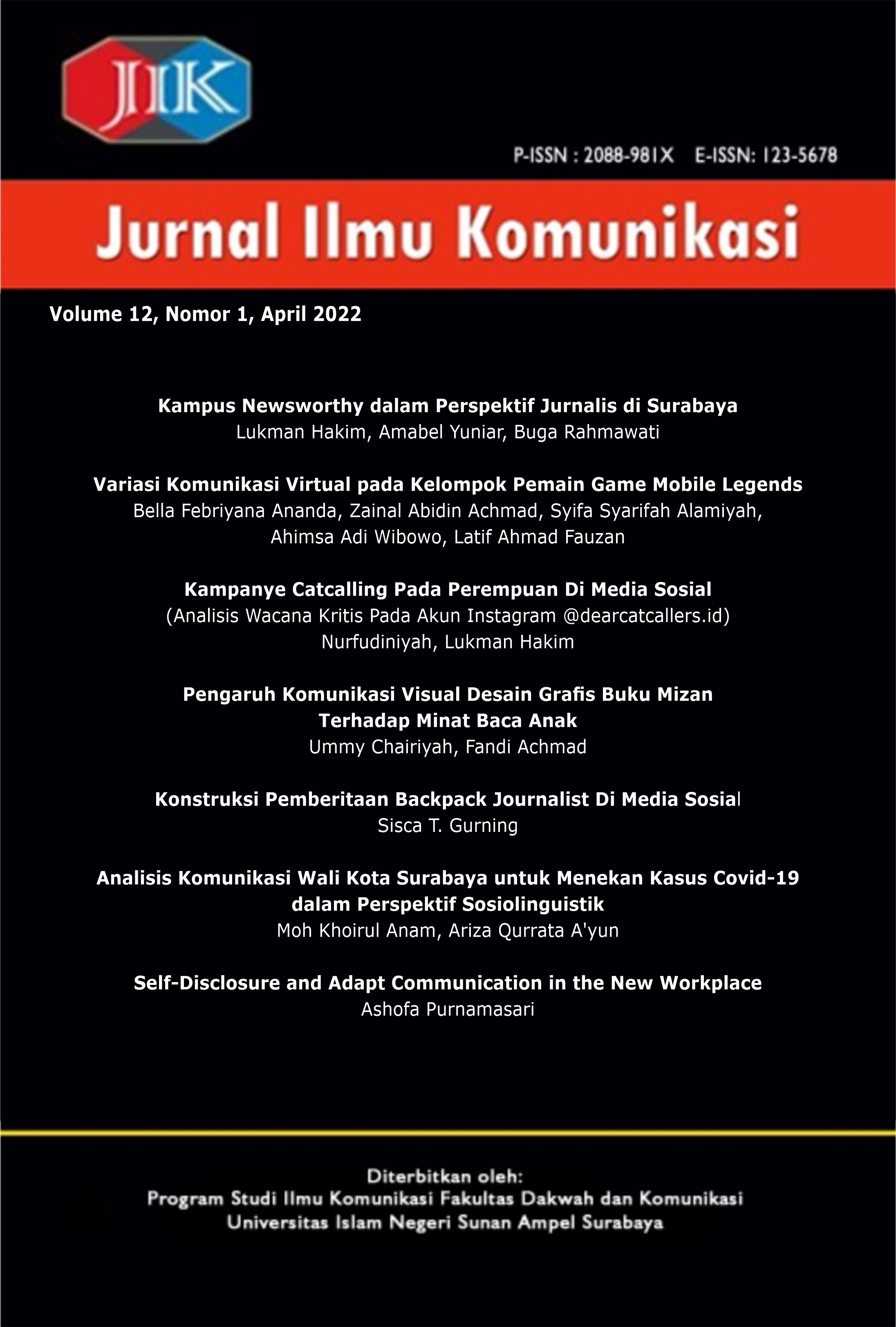Self-Disclosure and Adapt Communication in the New Workplace
DOI:
https://doi.org/10.15642/jik.2022.12.1.99-113Keywords:
Organization Communication, Socialization Process, Self-disclosure, NewcomersAbstract
The newcomers within an organization must carry out a socialization process, therefore, employee onboarding into organizations is seen as essential for the process of adaptation to the organizational culture. One of the things newcomers can do during the socialization process is to adapt and get to know the organization and the actors in the organization through adapt communication. This study seeks to find out how newcomers in MAX Academy and PT ARISTA organizations manage self-disclosure in the organization through the socialization process; early socialization, encounter, and metamorphosis. The results have revealed that in the newcomer self-disclosure practice there are limitations in self-disclosure to colleagues, such as age gap and educational status. However, the lack of self-disclosure does not prevent newcomers from continuing to carry out the socialization process with various predetermined stages. Additionally, the observed companies have different styles in fostering new employees in the socialization process, namely MAX Academy provides a program called onboarding to help newcomers in the socialization process, meanwhile PT ARISTA gives fully authority to newcomers to use their own model in the socialization process into the new organizational culture
Downloads
References
Allen M. W., Coopman S. J., Hart J. L., Walker K. L. “Workplace Surveillance and Managing Privacy Boundaries.” Management Communication Quarterly 21, no. 2 (2007): 172-200. https://doi.org/10.1177/0893318907306033
Altman, Irwin and Taylor, Dalmas A. Social Penetration: The Development of Interpersonal Relationship. USA: Rinhart & Winston Inc, 1973.
Ashforth, B. E., Kreiner, G. E., & Fugate, M. “All in a Day’s Work: Boundaries and Micro Role Transitions. Academy of Management Review 25 no. 3 (2000): 472–491. http://dx.doi.org/10.5465/AMR.2000.3363315
Crossman, J.A. “Being on the Outer: The Risks and Benefits of Spiritual Self-disclosure in the Australian Workplace.” Journal of Management & Organization 21, no. 6 (2015): 772-785. https://doi.org/10.1017/jmo.2015.6
Devito, J.A. Interpersonal Communication Book. England: Pearson Education Limited, 2016.
Dumas, T. L., Rothbard, N. P., & Phillips, K. W. “Self Disclosure: Beneficial for Cohesion in Demographically Diverse Work Groups?” Research on Managing Groups and Teams, 11 (August 2008): 143-166. http://dx.doi.org/10.1016/S1534-0856(08)11007-6
Fredric M. Jablin & Linda L. Putnam: The New Handbook of Organizational Communication. SAGE Publications, Inc. 2011. https://dx.doi.org/10.4135/9781412986243
Griffin, E. A first look at communication theory (8th ed.). New York: McGraw-Hill, 2012.
Hasniar, Muhammad Qadaruddin, Nurhakki. “Self Disclosure Dalam Membentuk Level Hubungan Interpersonal Perspektif Gender di Asrama Putra dan Putri STAIN Parepare. Komunida: Media Komunikasi dan Dakwah” 8, no. 1 (Nopember 2018): 77-96. https://almaiyyah.iainpare.ac.id/index.php/komunida/article/view/602
McPherson, J. M., & Smith-Lovin, L. “Homophily in voluntary organizations: Status distance and the composition of face-to-face groups.” American Sociological Review 52, no 3 (1987): 370–379. http://dx.doi.org/10.2307/2095356.
Miller, K. Organizational Communication: Approaches and Processes. (6th ed.). Boston: Wadsworth Cengage Learning, 2012.
Muchinsky, Paul M. “Organizational Communication: Relationships to Organizational Climate and Job Satisfaction.” Academy of Management Journal 20, no. 4 (December 1977): 592–607. https://doi.org/10.2307/255359
Notoatmodjo, S. Penelitian Methodologists Kesehatan. Jakarta: Rineka Cipta, 2010.
Petronio, Sandra and Rachel Hernandez. Communication Privacy Management Theory. Oxford University Press, 2022. https://doi.org/10.1093/acrefore/9780190228613.013.373
Robinson, S.C. ”Self-Disclosure And Managing Privacy: Implications For Interpersonal And Online Communication For Consumers And Marketers. Journal of Internet Commerce, 16, no. 4 (2017) : 385-404. https://doi.org/10.1080/15332861.2017.1402637
Smith, S. A., & Brunner, S. R. “To reveal or Conceal: Using Communication Privacy Management Theory to Understand Disclosures in the Workplace.” Management Communication Quarterly, 31, no. 3 (2017): 429–446. https://doi.org/10.1177/0893318917692896
Tiedens, L. Z., Unzueta, M. M., & Young, M. J. An Unconscious Desire for Hierarchy? The Motivated Perception of Dominance Complementarity in Task Partners.” Journal of Personality and Social Psychology 93, no. 3 (2007): 402–414. http://dx.doi.org/10. 1037/0022-3514.93.3.402
Uhlmann, E. L., & Sanchez-Burks, J. “The Implicit Legacy of American Protestantism.” Journal of Cross-Cultural Psychology 45, no. 6 (2014): 992–1006. http://dx.doi. org/10.1177/0022022114527344
Uhlmann, E. L., Heaphy, E., Ashford, S. J., Zhu, L., & Sanchez-Burks, J. “Acting Professional: An Exploration of Culturally Bounded Norms Against Nonwork Role Referencing.” Journal of Organizational Behavior 34, no. 6 (2013): 866–886. https://doi.org/10.1002/job.1874
Willer, R. “Groups Reward Individual Sacrifice: The Status Solution to the Collective Action Problem.” American Sociological Review 74, no. 1 (2009): 23–43.
Downloads
Published
How to Cite
Issue
Section
License
Copyright (c) 2022 Ashofa Purnamasari

This work is licensed under a Creative Commons Attribution-ShareAlike 4.0 International License.












